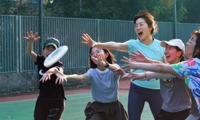
Xu, Min (Lecturer) Lecturer
School of Biomedical Engineering
Lecturer
Department of Medical Information Engineering
BIOGRAPHICAL SKETCH
NAME: Xu, Min
POSITION TITLE: Lecturer, School of Biomedical Engineering, Shenzhen University Health Science Center
EDUCATION/TRAINING
|
INSTITUTION AND LOCATION |
DEGREE (if applicable)
|
Completion Date MM/YYYY
|
FIELD OF STUDY
|
|---|---|---|---|
|
Sun Yat-sen University, Guangzhou, China |
B. Sc. |
06/2009 |
Psychology |
|
The University of Hong Kong, Hong Kong |
Ph.D. |
09/2014 |
Neurolinguistics |
A. Personal Statement
My research mainly utilizes neuroimaging techniques and behavioural measures to investigate the neurocognitive mechanisms underlying language processing, language disorders and bilingualisms. In particular, we examine how language may shape our brains, how bilingual brains handle different languages, and the neural basis for language disorders such as developmental dyslexia. I have published papers on these topics in peer-reviewed professional journals including PNAS, Science Advances and Human Brain Mapping. My research has been supported by the National Natural Science Foundation in China (NSFC) and a Shenzhen Basic Research Grant.
B. Positions and Honors
Positions and Employment
05/2015– present Lecturer, School of Biomedical Engineering, Shenzhen University Health Science Center
C. Contributions to Science (*:corresponding author, #: co-first author)
A full list of my publications is enclosed at the end of this document.
1. Functional organization of language in the bilingual brain
The human brain is equipped with a remarkable ability to acquire more than one language, as is apparent in bilingual individuals. But it remains to be understood how the bilingual brain handles different languages. Previous neuroimaging studies have generally found very similar brain regions activated by different languages. In our recent fMRI study published in Science Advances, we found that though the two languages use similar regions, they involve interleaved but functionally independent neural populations within the cortical regions. We used a multivariate pattern analysis technique to decode the neural signals evoked by Chinese and English stimuli and found a significant separation of neural patterns for the two languages in multiple language-related brain regions. The separation percentages of critical voxels were as high as 50.1% - 96.5% across regions. Neural segregation of each language may be crucial for bilingual speakers to use each language appropriately and avoid cross-talk. This study was highlighted by This Week in Science (Issue 6347).
- Xu M., Baldauf D., Chang C. Q., Desimone R., Tan L. H. (2017) Distinct distributed patterns of neural activity are associated with two languages in the bilingual brain. Science Advances 3, e1603309.
2. Neurocognitive deficits associated with Chinese reading impairments
Developmental dyslexia is a neurological condition characterized by unexpected low reading performance in people with normal intelligence and typical schooling. It remains hotly debated as to the core deficits associated with dyslexia. By using fMRI, we found abnormal hemispheric asymmetry in Chinese dyslexics in brain regions subserving the storage and manipulation of phonological information. The degree of leftward asymmetry correlates positively with reading performance. This finding offers insight into the biological dysfunction and possible remediation of developmental dyslexia.
In another large-scale (n = 5851) study, we found that the overall incidence of severe reading difficulty appears to be much higher than ever reported on Chinese reading. Crucially, we found that children’s reading scores were significantly negatively correlated with their use of the pinyin input method, suggesting that pinyin typing on e-devices may hinder Chinese reading development. Conversely, handwriting seems to facilitate this learning. Our results suggest that the benefits of communicating digitally may come with a cost in proficient learning of written Chinese.
1) Xu M.*, Yang J., Siok W.T. & Tan L.H. (2015) Atypical lateralization of phonological working memory in developmental dyslexia. Journal of Neurolinguistics 33:67-77.
2) Tan L.H.#, Xu M.#, Chang C.Q., & Siok W.T. (2013) China’s language input system in the digital age affects children’s reading development. Proceedings of the National Academy of Sciences of the United States of America 110(3):1119-1123.
3. Brain connectivity in language processing
Language is a higher order brain function that involves complex networks of functional pathways connecting anatomically distinct regions. In an fMRI study published in Human Brain Mapping in 2015, we used dynamic causal modeling to characterize how the brain regions dynamically interact with one another during Chinese reading. Our results showed that visual word recognition in Chinese engages the ventral pathway from the visual cortex to the left ventral occipitotemporal cortex. The ventral pathway is linked to the superior parietal lobule and the left middle frontal gyrus (MFG) so that a dynamic neural network is formed, with information flowing from the visual cortex to the left ventral occipitotemporal cortex to the parietal lobule and then to the left MFG. The results are in contrast with previous neuroimaging studies, which reported that lexical processing in alphabetic languages involves both ventral and dorsal neural pathways originating from the visual cortex. Our findings suggest that cortical dynamics is constrained by the differences in how visual orthographic symbols in writing systems are linked to spoken language.
Xu M., Wang T., Chen S., Fox P.T., & Tan L.H. (2015) Effective connectivity of brain regions related to visual word recognition: An fMRI study of Chinese reading. Human Brain Mapping 36:2580-2591.
D. Research Support
Ongoing Research Support
NSFC (China) (31700951) 01/01/2018 to 12/31/2020
Min Xu, PI ¥200,000 (direct cost)
Multimodal brain-network mechanisms and diagnosis of Chinese dyslexia
Shenzhen Basic Research Grant (JCYJ20170412164259361) 07/01/2017 to 06/30/2020
Min Xu, PI ¥2,000,000
Deficits of neural pathways in Chinese dyslexia and its clinical application
E. Peer-reviewed publications (*:corresponding author, #: co-first author)
1. Xu M., Baldauf D., Chang C. Q., Desimone R., Tan L. H. (2017) Distinct distributed patterns of neural activity are associated with two languages in the bilingual brain. Science Advances 3, e1603309. (Highlighted by This Week in Science, Issue 6347)
2. Mu S.H., Xu M., Duan J., Zhang J., & Tan L.H. (2017) Localizing Age-Related Changes in Brain Structure Using Voxel-Based Morphometry. Neural Plasticity Article ID 6303512.
3. Xu M.*, Xu G.P., &Yang Y. (2016) Neural systems underlying emotional and non-emotional interference processing: an ALE meta-analysis of functional neuroimaging studies. Frontiers in Behavioral Neuroscience 10: Article 220.
4. Yan H., Zhang Y.M., Xu M., Chen H.Y., & Wang Y.H. (2016) What to do if we have nothing to rely on: Late bilinguals process L2 grammatical features like L1 natives. Journal of Neurolinguistics 40:1-14.
5. Xu M., Wang T., Chen S., Fox P.T., & Tan L.H. (2015) Effective connectivity of brain regions related to visual word recognition: An fMRI study of Chinese reading. Human Brain Mapping 36:2580-2591.
6. Xu M.*, Yang J., Siok W.T. & Tan L.H. (2015) Atypical lateralization of phonological working memory in developmental dyslexia. Journal of Neurolinguistics 33:67-77.
7. Xu, M. (2015). "Character Amnesia." Encyclopedia of Chinese Language and Linguistics. General Editor Rint Sybesma. Brill Online.
8. Zhu, Z., Wang, R., Kao, H.S., Zong, Y., Liu, Z., Tang, S., Xu, M., Liu, I.C., and Lam, S.P. (2014). Effect of calligraphy training on hyperarousal symptoms for childhood survivors of the 2008 China earthquakes. Neuropsychiatric Disease and Treatment 10, 977.
9. Tan L.H.#, Xu M.#, Chang C.Q., & Siok W.T. (2013) China’s language input system in the digital age affects children’s reading development. Proceedings of the National Academy of Sciences of the United States of America 110(3):1119-1123.
10. Xu M., Kao H.S.R., Zhang M.L., Lam S.P.W., & Wang W. (2013) Cognitive-Neural Effects of Brush Writing of Chinese Characters: Cortical Excitation of Theta Rhythm. Evidence-Based Complementary and Alternative Medicine 2013:1-11.








用户登录
还没有账号?
立即注册